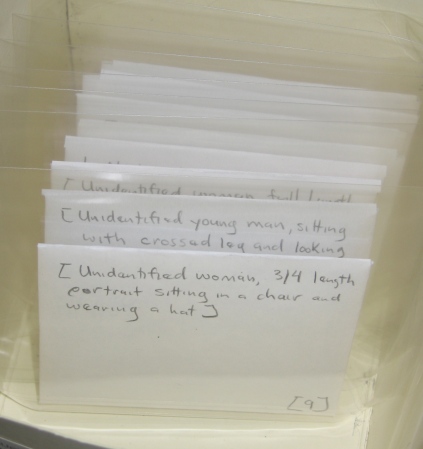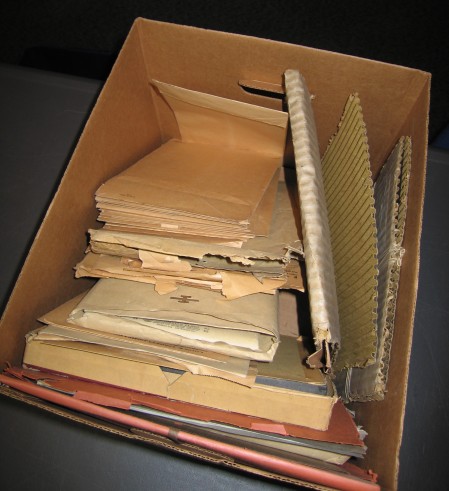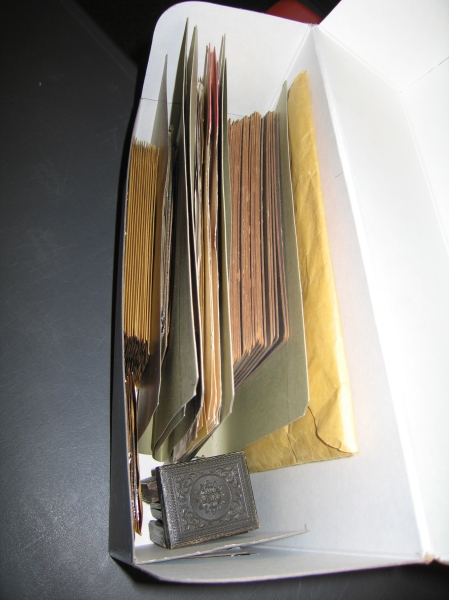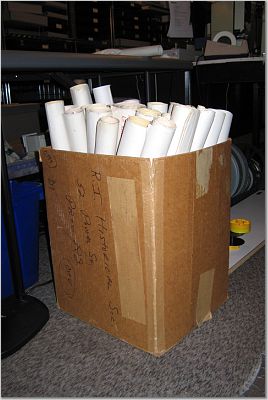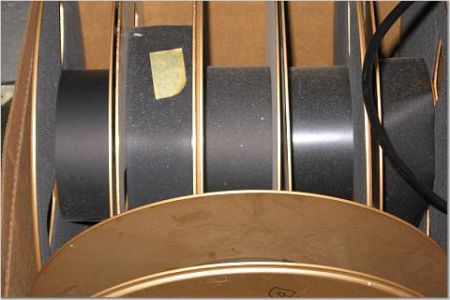Written by James DaMico, Special Collections Curator
At 5pm on July 31st, the most comprehensive inventory of our Graphics collection backlog was completed. A total of 7,800 new catalog entries were created, and 257,524 items were processed.
The 7,800 catalog records represent collection level and single item entries. This total represents approximately 800 linear feet of previously hidden collections. Or to put it another way, about 8 football fields worth of material laid out end to end.
Here’s a breakdown by type of object:
| Object Type | Total |
|---|---|
| NEGATIVES (Glass, Nitrate, Safety) | 52,780 |
| DIRECT PHOTOGRAPHS (Tintypes, Daguerreotype, Ambrotypes) | 1,204 |
| TRANSPARENCY FILM (35mm, 16mm, stereoscopic, etc.) | 29,821 |
| PHOTOGRAPHIC PRINTS (Cabinet cards, albumen, silver gelatin, etc.) | 109,094 |
| MECHANICAL PRINTS (Engravings, halftones, etc.) | 18,993 |
| VOLUMES (Photo albums, scrapbooks, etc.) | 2,009 |
| DRAWINGS (Watercolor, Pencil,Charcoal,etc.) | 3,998 |
| ARCHITECTURAL DRAWINGS | 13,818 |
| ENGINEERING/MECHANICAL DRAWINGS | 1,281 |
| BROADSIDES | 900 |
| MAPS | 3,035 |
| AUDIO | 3,375 |
| MOVING IMAGE: FILM | 657 |
| MOVING IMAGE: VIDEO | 491 |
| EPHEMERA | 16,106 |
This Graphics Inventory project, initiated with an 18 month grant from an anonymous donor interested in the Society’s amazing graphics collection, officially began on January 16, 2007. We soon realized that 18 months wasn’t nearly enough time for this mammoth undertaking so an application was made to the Institute of Museum and Library Services (IMLS) for a Museums for America grant.
In 2009, great news was delivered when the Society was informed by the IMLS that we were awarded a 3 year, $99,400 grant to complete this project. The staff who worked on the application can be proud to know that the Society was one of 154 grant recipients out of a total of 371 applicants.
What makes this project so important is that we are able to input the entire backlog into one unified database instead of the information being in multiple disparate locations such as shelf lists. At the time, before the launch of our on-line catalog NETOP, creating an Access database to capture all of the relevant information was decided to be a wise idea. From the Access database we can now export the 7,800 catalog records that were created over the last 5.5 years into NETOP.
But this project wasn’t just about counting – each object in each collection was looked at, described and generally re-housed in archival materials. In total, 257,524 individual items were looked at and added to the appropriate object type. What this means is that for collection level records, we now know how many of a particular item, say Cabinet card photographs, are in a given collection. Some collections that were found in their original, strewn together arrangement could take up to 2 weeks to process and instill a usable order.
A box of carefully house glass plate negative.
The first sort!
Yes, this collection actually came in a Chiquita banana box!
The inventory shows us that we are weak in visual material for the better part of the mid to late 20th century especially for the towns and cities outside of Providence and it also shows that our holdings are not very diverse. This will allow us to make very precise acquisitions decisions. Another great aspect of this project is that we can now re-link collections that had been intellectually broken apart in years past thus reestablishing the context of the records creators across all of our collecting areas of museum objects, manuscripts and printed material.
Some basic statistics that have been culled from the Inventory project tells us that of the total number of individual items:
- 20.5 percent are photographic negatives
- 42 percent are photographic prints dating from the 1850’s to the 20th century
- 82 percent of the 7800 collections inventoried need to be cataloged
- 66 percent of the collections need some type of new archival housing
- Only 2% or 165 of the collections have a finding aid or a mention in a finding aid
In addition, the data shows that we will need to purchase some 146, 574 archival enclosures. This ranges from simple boxes and folders to oversize map folders and four flap enclosures for glass plate negatives. This survey shows that it isn’t free to house and provide access to researchers these very special collections and how important it is to have the proper funding for archival supplies to provide long term care for the collections under our roof.
For example, to properly house a collection of 100 one of kind glass plate negatives would cost approximately $240.
This does not include the labor, employee benefits, heating and cooling the building, electric, phone, insurance and water bills. If an item needs professional conservation work the expense goes up even higher.
In addition, many items or collections that were thought missing were found again and a few rare items were rediscovered such as Ambrose Burnside’s passport and a rare 1841 Dorr War broadside.
For internal staff, the Graphics Inventory means that they can now search for items in one central database thus allowing them to make more informed acquisitions decisions. Accession information such as an intake date, that was found with or on an item is also included in the Inventory. Moreover, the data that has been captured will allow the staff to prioritize processing projects and write grants to purchase archival supplies and process collections more fully.
It is a great feeling to clear up a 30 year backlog!


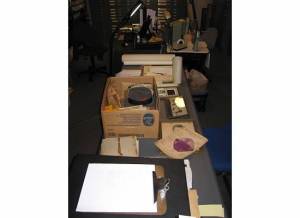
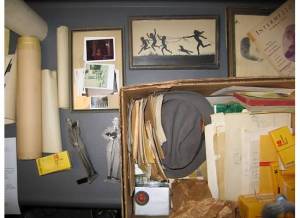
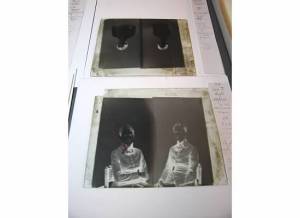




 Posted by 2010rihsgraphics
Posted by 2010rihsgraphics 



